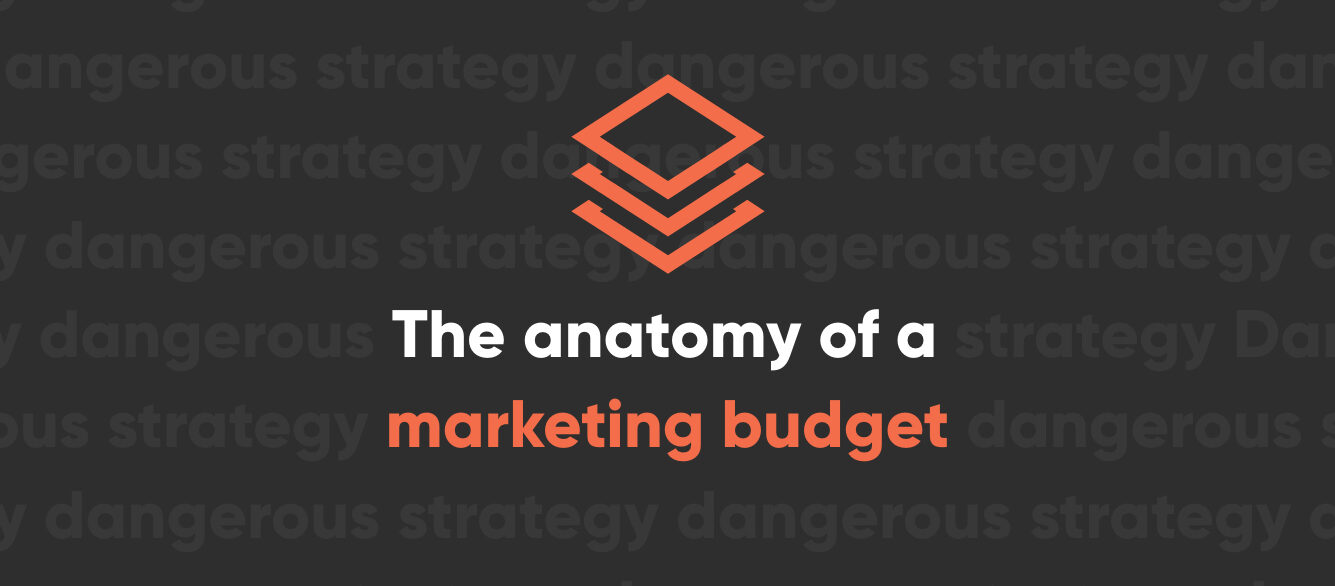
The anatomy of a marketing budget

The biggest issue most businesses face when setting up a marketing budget is that they simply don’t know where to begin.
Which channels should I utilize? How much should I spend on a given service? Should I bring in some outside help?
All these questions and more can become quickly overwhelming, resulting in many companies taking the worst possible course of action: doing nothing.
Marketing has become an absolute necessity for successful businesses today. You either strategize and launch some form of a marketing plan, or you watch your competitors surpass you.
With that said, doing so is still a complex process that requires critical thinking and an analysis of your resources in order to see success. Which is why we’ve put together a high-level view of how to assemble a marketing budget, complete with:
- How much you should spend on marketing
- Where you should spend your marketing budget
- How you should spend your marketing budget
In diving into these three questions, we’ll uncover how to go about building your own marketing budget from the ground-up to sustain long-term success.
But before we do, I want to point out that there’s no such thing as a “perfect” marketing budget that can be applied to all businesses and industries. The recommendations below are based off of the Perrill team’s experience helping a wide variety of brands strengthen their digital reach for more than 25 years.
The goal here is to provide you with what you need to create your perfect marketing budget – one that generates growth and accomplishes your goals.
So let’s start there.
What are your goals?
The reason this should be the first question you ask because your budget should ultimately be driven by your goals.
Maybe you’re in aggressive-growth mode and can allocate resources toward growing your audience on an exponential basis.
Perhaps it’s been a lean year and you need to be more conservative with your spend until you can take a more targeted approach.
Whatever your goals are, clearly defining them before diving into your budget will help guide the rest of the process.
“… businesses aggressively pursuing growth need to aggressively prioritize marketing.”
How much should I spend on my marketing budget?
Okay, so you’ve established your goals. Now you’re wondering how much you should spend without going overboard but still promoting sustainable growth.
In general, we recommend businesses spend at least 5% of their gross revenue on marketing. This minimum level of spend is enough to simply keep the department (and the business) alive – but shouldn’t be expected to deliver much value beyond that.
As far as a standard baseline, we view 10% as a reliable average for businesses pursuing slight growth that may be sustainable.
For growth-oriented businesses, we recommend 20% of the total gross revenue be dedicated to marketing. As mentioned, marketing is now an essential component of every successful business – and businesses aggressively pursuing growth need to aggressively prioritize marketing.
Where should I spend my marketing budget?
When we ask this question, we are essentially talking about which forms of marketing your budget should include.
We recommend marketing in five key areas:
- Ads
- Content
- SEO
- Website
Each of these areas is reliant on the success of the others. To have the most success, you should be operating in a variety of these different areas and ensuring they all work together cohesively.
For example, if you devote the entirety of your budget to ads and SEO, a lot of users might make it to your site. But if your site and its content aren’t optimized to take users the rest of the way, the strategy has ultimately failed.
Below we recommend a percentage of your marketing budget that should be devoted to each of these five key areas. These percentages were generated by taking baseline research and applying our decades of experience to it to determine what the most effective businesses are and should be spending.
Ads – 36% of total marketing budget
Your ads budget should incorporate all associated costs, including ad creation, ad spend, campaign management, and any additional tools required to manage your account.
A digital advertising budget can also leverage a variety of different channels, the best of which will depend on your industry and audience. Whether you’re advertising on social media, in video, in search, or in a combination of several different platforms (which we hope is the case), make sure you’re seeing returns on what you’re putting in.
Content – 16% of total marketing budget
Content marketing is an increasingly hot space right now, with many people promoting it as a large chunk of the budget. And there’s good reason for this.
Content not only plays a big role in getting users to your site, but it also plays a massive role in leading them down a purchase path toward that sweet, sweet conversion.
But content is not something you can just set and forget. Once you create high-quality content, make sure you’re taking steps to properly promote it and drive traffic to it.
As with ads, everything to do with content creation should be factored into this budget area. That means content creation, management, promotion, and more.
Email – 10% of total marketing budget
Email is one of our favorite areas of digital marketing, thanks mostly to its ability to deliver great ROI. For the most part, it’s incredibly inexpensive to create and send marketing emails, and they can often lead to great reward. It’s not uncommon for us to see clients experience 10-15x return on an email campaign.
SEO – 12% of total marketing budget
A lot of non-marketers don’t understand a whole lot about SEO, which can result in too many shying away from it – but the reality is every business should be investing some money in SEO.
SEO can provide tremendous return potential by generating “free” clicks. We say they’re “free” because they come from organic traffic, but there are obviously costs associated with time and labor, as well as any agency costs that may come into play if you go that route.
Some industries inherently have less search volume and can thus get by devoting less toward SEO, but pairing a sound SEO strategy with quality content is always a great way to drive traffic from the right audience.
Website – 14% of total marketing budget
Once these channels get users to your website, the website finishes the job. Or at least, it should – as long as it’s designed to do so.
This 14% baseline may be higher if you’re an enterprise eCommerce business than if you’re a small B2B brand, but in general it will include the cost of redesigns, hosting, content management, and more.
You should never feel like your website updates are “done.” Continually investing in your website in the long-term is worth it and is the cherry on the top of your greater user experience. Give it the love it deserves.
If you're doing the math, you probably noticed that doesn't add up to 100%. We've left some wiggle room here for miscellaneous marketing that doesn't fit into any of these buckets. You could also reallocate those additional dollars to these marketing channels based on performance.
How should I spend my marketing budget?
Now that we’ve broken down where you should spend your budget, we need to take a look at how to do so. That is, how your spending varies in each of these five areas in terms of labor, technology, agency*, and media*. *if applicable
Labor
Labor is your workforce – the professionals you’re paying to manage your marketing areas from SEO and content to email and ads. For the sake of the typical budget, we’ll break labor into three levels: Specialist, Manager, and Director.
In the areas included in your marketing strategy, assess which level of employee you need. Some employees might say they can specialize in multiple areas at once, but the reality is you’re going to sacrifice quality in one or more areas if you go down this path. One employee focusing on both content and ads is rarely more effective than two employees doing the same.
Technology
As digital marketing has grown, so has the number of tools available to help facilitate those efforts. From MailChimp and HubSpot to SEMrush and Google Ads, there are a multitude of platforms to help you get the job done.
Most offer free plans with limitations and paid plans that include increased capabilities, reporting, automation, etc. Depending on your budget, you may be able to get by with a free plan in some areas while needing to spring for a more advanced version in others. Take note of your goals and budget to help line this us.
Agency
For businesses with limited in-house marketing expertise, the support of a professional agency can provide a major boost to digital efforts. This is mainly because agencies are (or should be) experts and have greater time and resources to direct toward marketing, whereas your business might not have the bandwidth to do so.
This isn’t to say you have to hand all of your marketing efforts off to an outside party. Maybe an agency only manages two or three aspects of your marketing strategy while you keep a couple in-house. Whatever the level of involvement, make sure what you’re paying for a given service is translating into meaningful growth through that channel.
Media
Media expenses primarily come into play with ads, where you’re spending on search ads, offline ads, video ads, etc. Most companies allocate 80% of their ads budget toward media spend.
Take a look at your budget and needs per marketing area to determine where you can allocate funds across each. If your email budget is low and you already have an in-house specialist, you’ll likely be able to spend more on other areas – whether that’s SEO labor or ads support from a digital agency.
Key takeaways
Clearly, there are a lot of moving parts when it comes to putting together a marketing budget, with many factors that have to do with your unique goals, industry, and audience. Here are some of the main takeaways to keep in mind:
- The worst action you can take is to simply do nothing. Marketing is not going away and needs to be a priority in your greater business plan.
- The purpose of your marketing budget should not be to simply align with industry benchmarks, but rather to help generate growth and accomplish your goals.
- You should be spending at least 5% of your gross revenue on marketing. 10% is average, and 20% is for growth-oriented strategies.
- We recommend marketing in the five key areas of ads, content, email, SEO, and website, ensuring you do so cohesively so each area positively affects the rest.
- Once you determine where to spend your marketing budget, assess your goals and needs to determine how to spend your budget on labor, technology, agency support, and media.
Dial in your digital strategy with the experts at Perrill
The Perrill team is comprised of collaborative experts in the latest and most proven trends in digital advertising, SEO, content marketing, and much more. In more than 25 years as the original Minneapolis digital agency, we have helped countless local and national businesses establish themselves as online industry leaders.
Contact us today to learn more about how to craft and execute a strategy designed to get the most out of your ad spend.

Dan Cole
Join Our Newsletter


Why Google Shouldn’t Reveal Its Search Algorithm


8 Signs You Need a Website Redesign


